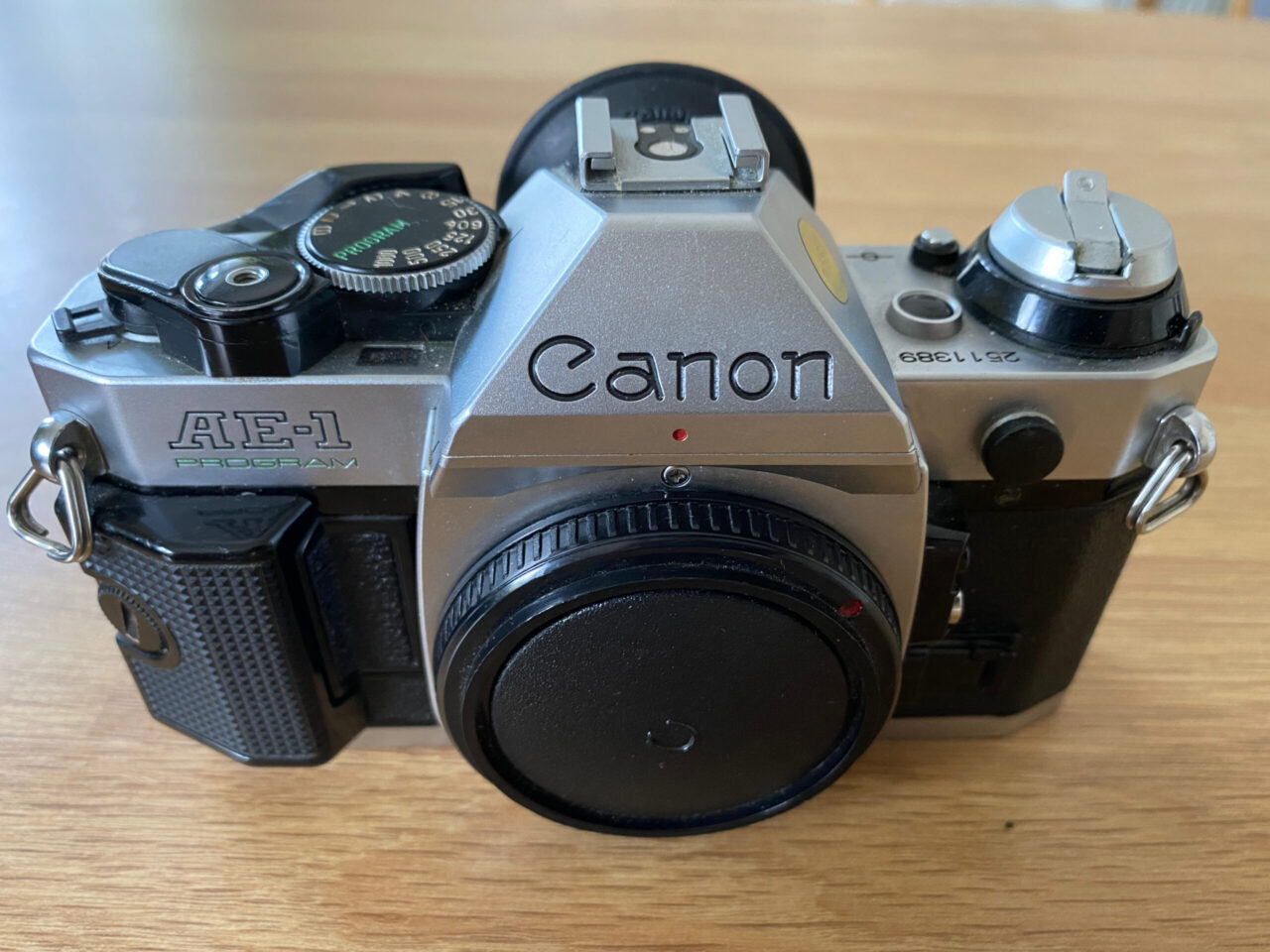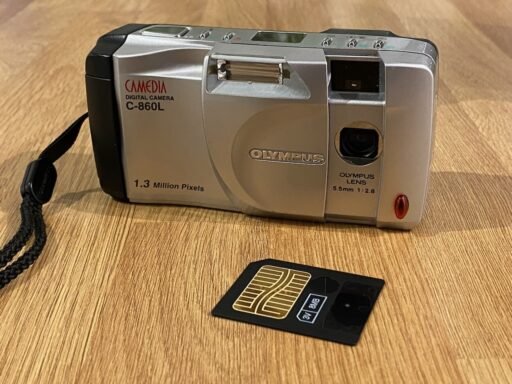Film – dated, outmoded, difficult to use, limited amounts of pictures, expensive and unavailable. Pointless in the age of digital. Right?
Wrong.
Let me be clear, this article is not about why anyone should abandon digital or prefer one form of photography over another. A balance of formats, styles and approaches will keep your interest for longer, broaden your photographic horizons and ultimately stop you from getting bored.
Film has recently seen a gradual and sustained resurgence, much like the return of vinyl records. Both formats arguably have far superior modern equivalents, why should you bother to go through the process of manually putting a record on when you can tap your phone and stream it wirelessly anywhere in the house? Why go to the hassle of loading a film, shooting pictures you can’t see until later and then having to develop them?
Let’s see if we can answer that question.
In this guide:
- Why shoot film in the days of digital?
- What do I need to shoot film?
- Isn’t it expensive?
- Which camera should I buy?
- Conclusion
- Useful links and resources
Why shoot film in the days of digital?
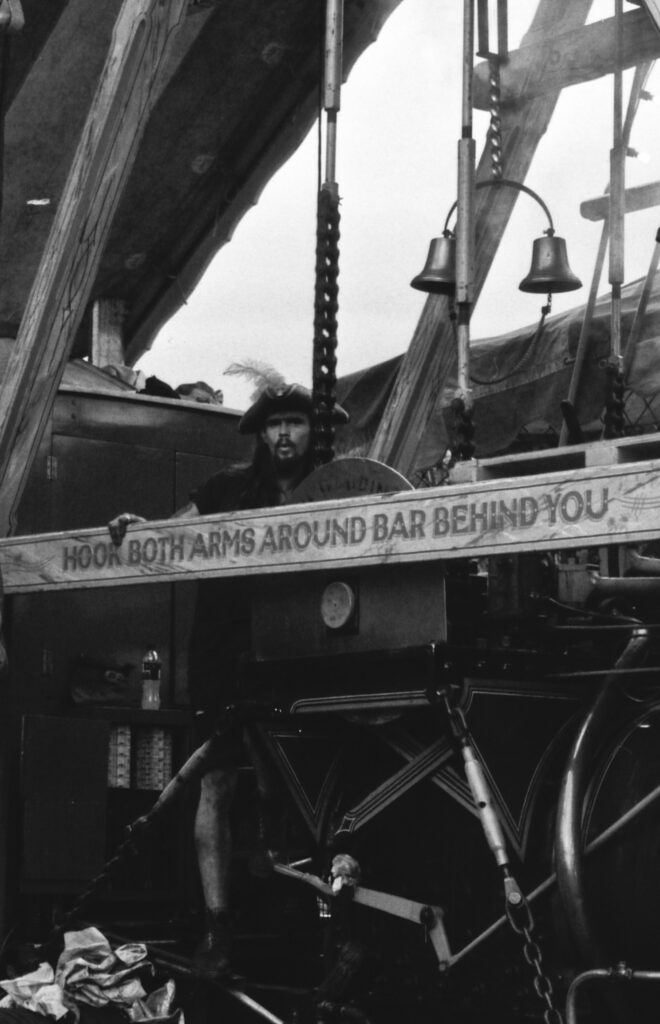
Modern society has provided us with convenience and instantaneous gratification. It has saved us space in our houses and we no longer need to dedicate shelves to CD’s, DVD’s, games or even books. You can fit everything you’ve ever read in your entire life into a space the size of your fingernail and carry them around on an e-reader to use and refer to anywhere in the world.
With all of these advances apparently improving our lives, surely it would be madness for anyone to want to return to older, slower and inferior ways of living our day to day lives. One common explanation for this tendency to want to live in the past is nostalgia, and of course this is certainly one aspect. Nostalgia may perhaps be the trigger for many a journey into older tech, but it isn’t enough to explain the sustained resurgence of certain formats like film.
Of course, not everything from our past was wonderful and there are certain things that I doubt anyone would honestly say they wish to experience again. Leaded petrol anyone? Those were the days! What about some dial up internet, getting cut off every 3 minutes or whenever someone picks up the phone. Don’t forget paying by the minute to use the web! No, thanks.
Continuing our earlier vinyl analogy, there are two obvious attractions of these more “analogue” experiences:
- Process
- Physicality
There’s a lot of noise in recent times about mindfulness. As far as I can understand this amounts to turning your phone off and going outside for a while. This all stems from that fact that those advantages of instant gratification, instant communication and convenience are also detrimental to our general wellbeing. Subconsciously, we have become addicted to information, our brains wired to constantly check for notifications, updates, live real-time information. How many times have you picked your phone up knowing full well there’s nothing to see, yet checked it anyway? What about just staring at it for no reason?
These habits that we’ve formed fill those gaps in our lives which used to be our natural downtime. The world 20 years ago was a vastly different place and all these little inconveniences actually went a long way to ensure that we did things in sensible, measured amounts. Don’t get me wrong, you could still spent 12 hours straight gaming every day if you wished, but life was absolutely more physically social, less based around devices, screens and finding ourselves constantly connected.
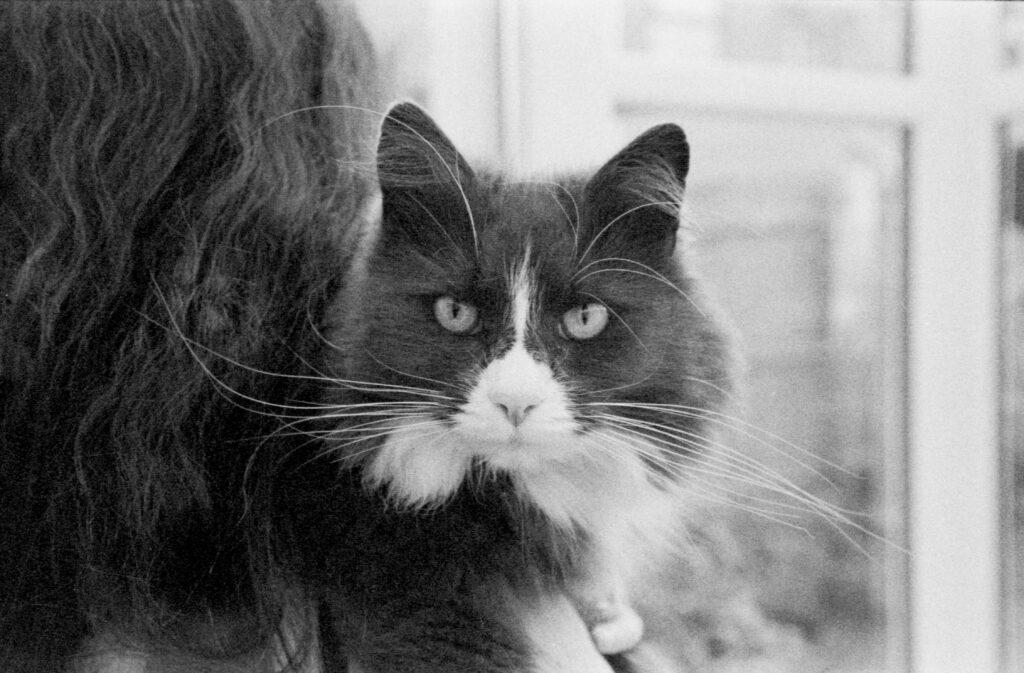
When people find themselves embracing and engaging in hobbies that involve old technology, we are actually rediscovering the positive side to just slowing down and disconnecting for a while. Yes, you can ask Siri or Alexa to play your favourite song, but it is such a hollow experience compared to physically holding that record in your hand, looking through the sleeve notes and photographs, carefully lining it up on a deck and gently dropping down a stylus.
These simple, subtle actions create an engaging connection with what you are doing, culminating in the whole experience from start to finish feeling all together deeper. You are far more likely to sit back, close your eyes and really listen to the music when you’ve put a record on than simply commanding it to magically appear and then being distracted by something else.
This “one thing at a time” mindset goes a very long way to improve your state of mind, but personally I’ve found it really difficult to adapt. I’ve had to learn that when I’m out with a camera, I’m not checking my phone, I’m not wondering about notifications and messages, I’m just doing photography and that’s it. I’m looking for patterns, shadows, detail, things that catch my eye or make me laugh. Once you learn to do this you discover the whole point of going analogue is that it’s good for you.
Can you do exactly the same with digital? Well, yes, but I would argue that you’re far less likely to switch off that instant gratification mindset. When you’re reviewing every shot, not only are you breaking that moment of calm that you’ve worked hard to find, worse you are likely reviewing shots and finding fault with most of them. If you walk around criticising yourself, you’re hardly likely to be enjoying yourself.
The wonderful thing about shooting film is you have no idea if the shot you envisaged is the one you’ll get or if it does really look that good when you see it in the flesh. This is a good thing for so many reasons, mainly that you don’t worry you’re not getting it right whilst you’re out.
When you do finally develop the film you learn everything about what you did well and what didn’t work. You’re then ready with a level head to go try new things next time. It’s so much more balanced, to the point where when I do test or use digital cameras, I never use the image review feature. I don’t look at a single image until I get home. Will I miss something? Who cares?
Finally, just like that vinyl analogy we can’t escape from, does it really sound better, warmer than digital music? Honestly, I don’t know, but like film it absolutely has a certain je ne sais quoi, there’s something about it that you can’t quite put your finger on, but it is definitely there. There’s something different.
With film it’s actually easier to describe, film undoubtedly looks different to digital images. To my eye, many digital images are just too crisp, clean and sharp. That sounds mad, but the grain of film combined with the optics of older lenses creates a softer, more pleasing aesthetic. Digital has never replicated the feel of film and that’s fine, that’s why we still have film and why you should use it.
If you develop your own films, and you should develop them yourself, then not only do you get that moment in time when you’re out clearing your mind, but you also get to experience the never ending magic of pulling a roll of images out of some water and that slow, methodical process of hanging, drying, checking, scanning negatives.
Analogue processes in our ever accelerating digital world have a lot going for them.
What do I need to shoot film?
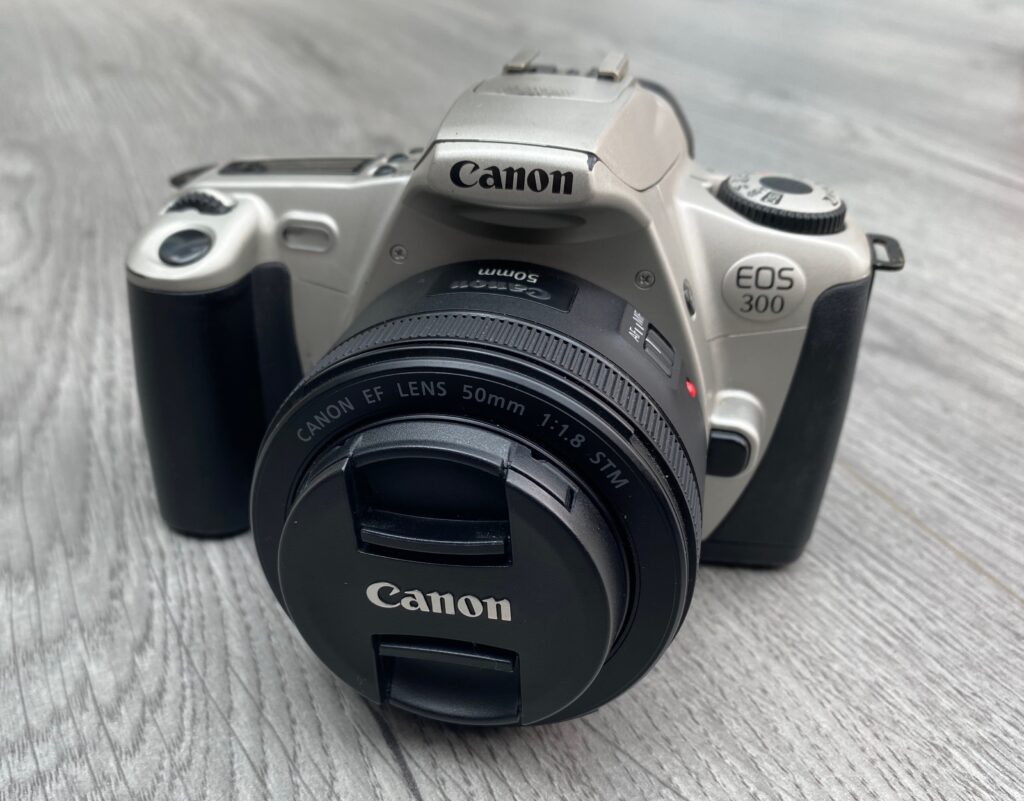
The short answer is £20-30 and an ebay account.
The sensible answer is that you’re going to need an SLR body, probably from Nikon or Canon. Next you’ll need a lens and I cannot recommend enough that you get yourself a 50mm f1.8 prime as your first lens. Finally, you’ll need some film and for that I recommend you start with Ilford, not because they’re cheap but because their films are just so well documented for virtually any use you can think of.
Optionally, you could look into developing equipment and I’ve written about how to do that on a budget in great detail here. If you don’t fancy jumping in with both feet until you’ve decided you actually like it enough to do so, then there are a surprising number of labs which are still open and some which specialise in black and white development.
That’s it, you don’t need anything other than camera, lens and film to get going and simpler you keep it, the easier it is to just enjoy what you’re doing. Don’t worry about gear or getting the best, just get something and have a go.
Isn’t it expensive?
Nope.
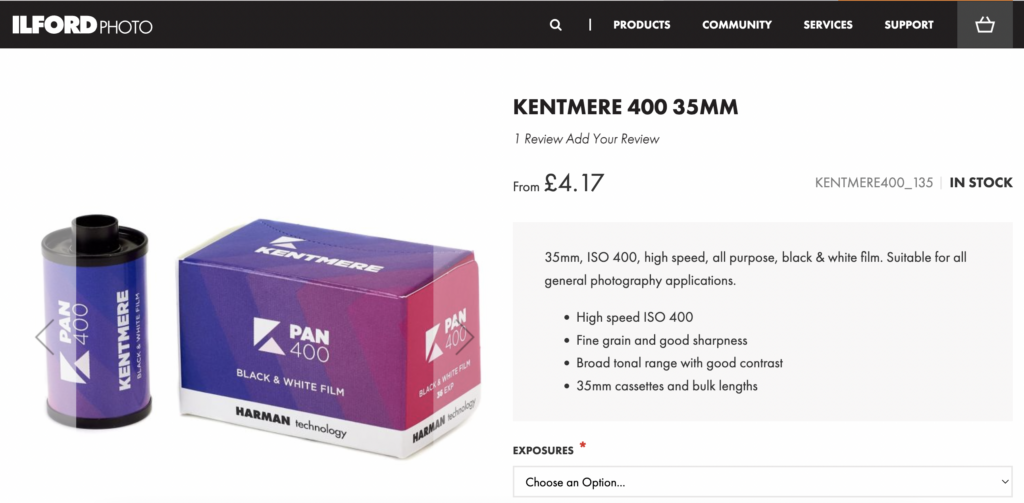
At the time of writing, according to the official Canon UK website, the cheapest mirrorless camera they sell which is aimed at actually taking photographs rather than “video conferencing” is the RP which retails for £1049 body only. You can get the cheaper M50 for £589.
As for DSLR bodies, the cheapest is the horrible 2000D at £409. The “enthusiast” option is the 850D at £919.
Of course you can buy second hand, and if you truly want digital bang for your buck then I heartily recommend the 10D, 20D, 30D bodies all of which can be picked up for £30 or less and are excellent performers even today (see my recent reviews by clicking the previous links). But the point is, you’re here because of at least a passing interest in film and the experience it brings, so what can you get for the equivalent price in the film world?
A roll of film today is approximately £4-5 depending on what you use. Let’s round up to £5 for simple maths. A working, perfectly reasonable EOS SLR can be purchased for as little as 99p if you’re really lucky, but definitely between £5-10 if you’re being thrifty. A 50mm f1.8 lens, which should be everyone’s first lens, can be bought for around £50.
The cheapest digital option, which will lack the ergonomics, clear bright viewfinder and other perks of using a film body, costs £409. For that price you could buy an SLR, 50mm lens and 68 rolls of 36 exposure film. That’s 2448 frames before you hit the price of a body only DSLR.
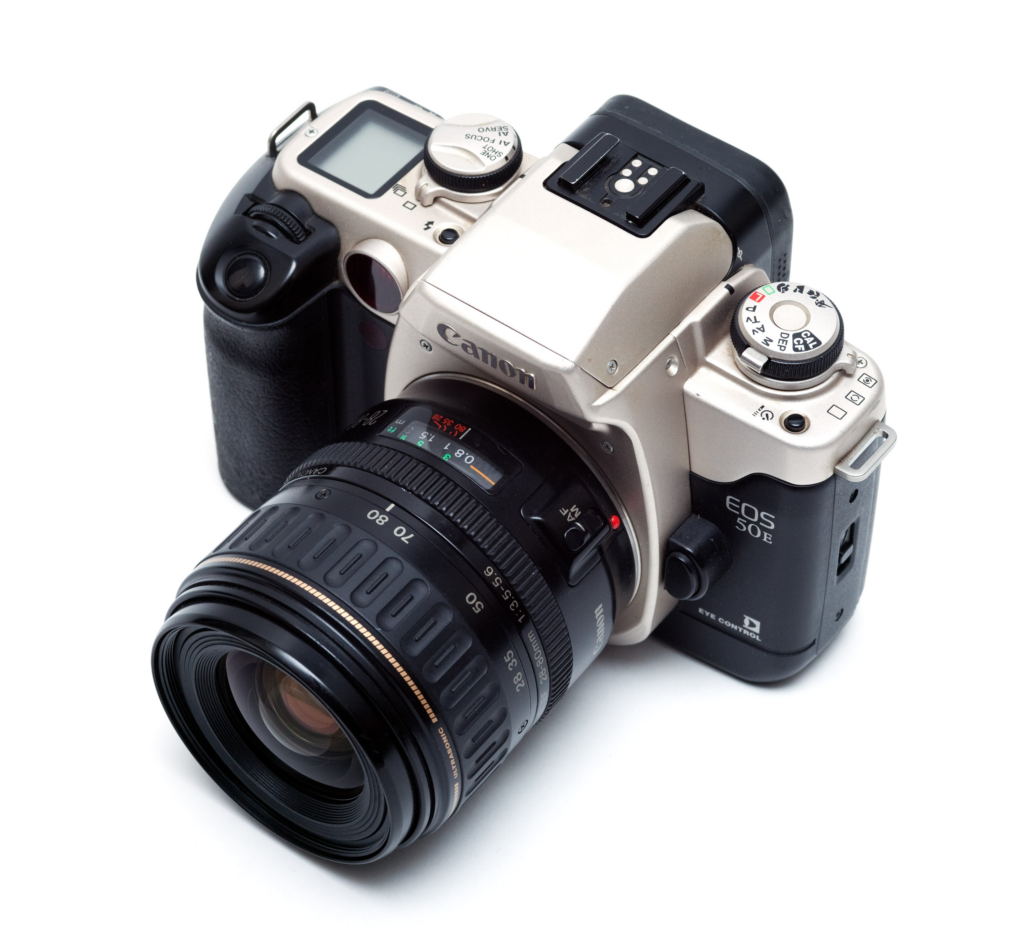
But why stay so cheap? If you have a little more budget, you can buy the absolute best of the best. A Canon EOS 1 will set you back around £75 and the excellent Canon EOS 1n will be approximately £150. These bodies were the peak of film technology and in terms of reliability, ergonomics, handling and all round experience you won’t beat them. These bodies were £2-3000 when new, they were serious tools, now available for next to nothing.
If you want something less expensive but still better than entry level? Try the EOS 50, yours for as little as £25 and capable of producing absolutely incredible images with solid build quality and handling. The point here is that not only is shooting film cheap, but you’ve got your pick of camera bodies (still compatible with modern lenses) which means you can have more than one body, or experience them all for less than the cost of a frankly terrible modern entry level DSLR.
Which camera should I buy?
It would be really easy to suggest you just buy the first and cheapest SLR you can lay your hands on that still works. This is definitely a valid option, but not the best idea for your first film camera.
The first and most important thing to consider is what kind of experience are you after? As a beginner, you’ve two choices to think about (we are only looking at 35mm here):
- Do you want the full manual experience? Solidly built, metallic cameras and lenses with manual focus, manual film advance and maybe a light meter built in for that fully slowed down, mindful film sensation?
- Do you want to have some of the perks of modern cameras such as accurate light meters, auto focus and a choice of modern lenses?
The full manual experience
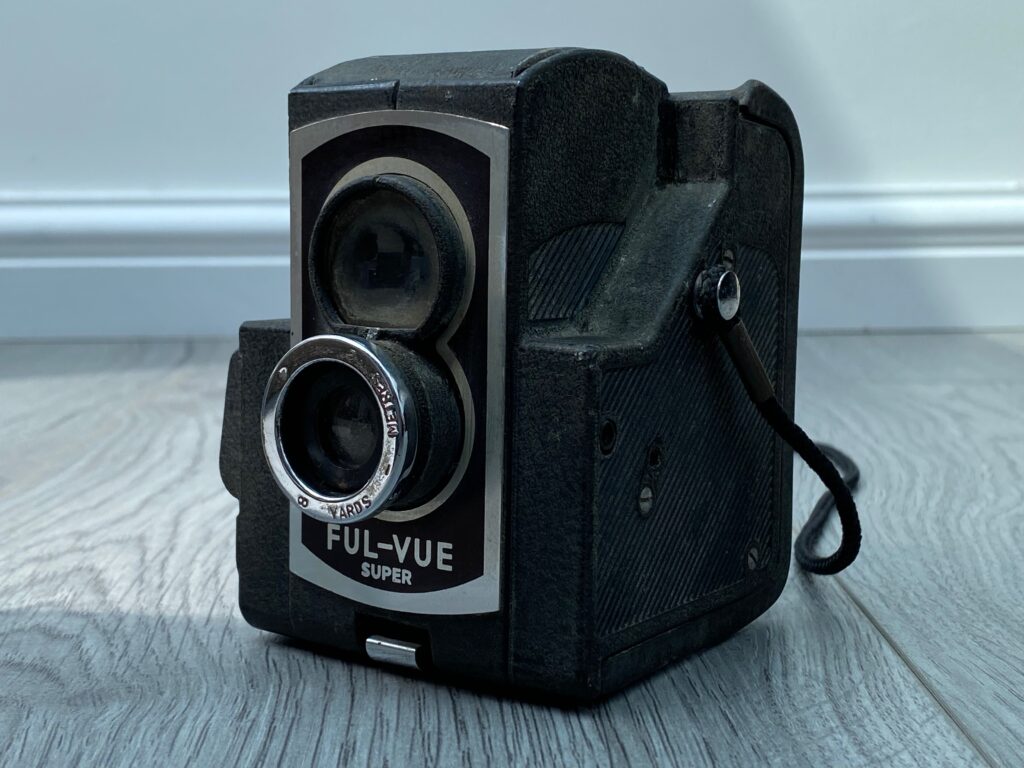
It doesn’t make much sense, but at the time of writing the older the camera, generally the more expensive it will be. All of the “good” models dating back to around 1970-80 are now fetching stupid money for no reason other than the market has decided they’re fashionable and collectible.
This makes it harder to recommend older cameras than it used to be. Don’t be tempted to go to a junk or antique store and pick up an old film camera for £5, you’ll end up with a total dog which may not even take 35mm film – there were loads of film formats from 1930-1980 that came and went before we were left with pretty much just 120 and 35mm.
If you want the tactile nature of a manual focus, manual winding camera then you should look at FD mount Canon bodies such as:
- AE-1
- AE-1 Program
- A-1
- F-1
Of all of these cameras, the AE-1 or AE-1 Program are the best choice for beginners, but make no mistake they are not beginner cameras! The AE-1 Program is one of the most popular old film cameras and this is because it provides everything you need in one place. It produces great images, has a decent light meter, solid build quality, good handling and ergonomics considering when it was made and access to a massive range of cheap, well built FD lenses.
If you can stretch a little further, the A-1 gives an almost identical experience but with slightly better build quality and a few more features.
You may need deep pockets for some of these cameras, as their popularity has inevitably made sellers believe their old cameras are now worth a fortune.
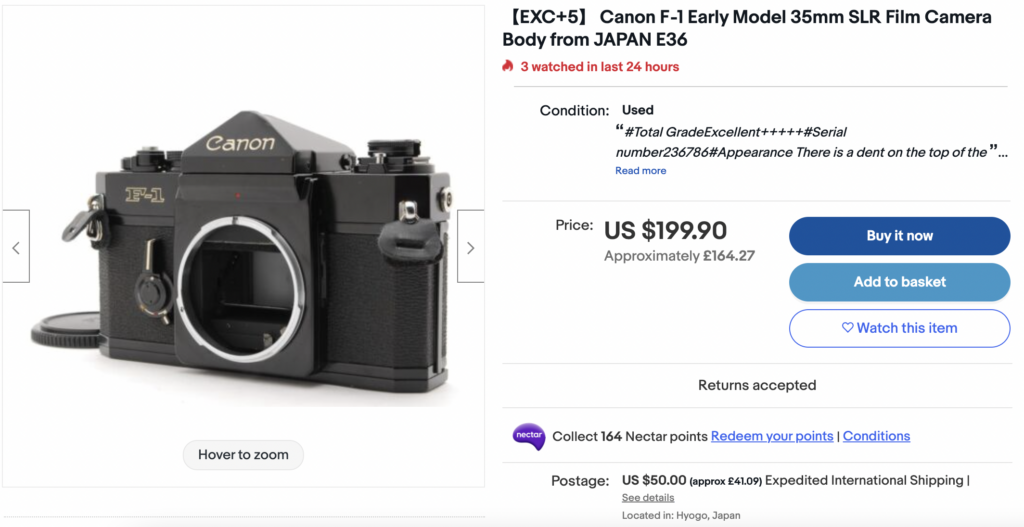
Alternatively, there’s an odd set of bridge cameras that Canon released to fill the gap between manual focus and the auto focus EF cameras. These are designed around automation and fitting in as many electronic aids as possible, although you still have manual focus and the ability to turn off features if you don’t want to use them. All of these bodies work with all FD lenses and you get the convenience of better metering and automatic film winding (if you want that).

These are the T series of cameras and the most common models are:
- T50
- T70
- T80
- T90
These are significantly cheaper than the previous A and F series cameras, but beware, build quality and reliability are nowhere near as good. Most T90’s are dead or will die at some point with a shutter fault. The T70 or T80 is not a bad option at all if you can get one for around £25, but just keep in your mind that they are likely to keel over at some point and far more so than their manual, last generation counterparts.

One interesting quirk about the T80 is that it was released at the same time as Canon’s first attempt at an auto focus lens. These lenses were called “AC” and try as I might, I cannot find out what AC actually stands for, even Canon don’t seem to know on their own site. Either way, they only ever made three of them and not for very long either. If you get to use one, they work, but they’re slow, noisy and above all – massive.
My knowledge and expertise lies almost exclusively in Canon bodies and lenses, however you can pick up manual SLR bodies for next to nothing from the other common brands such as Nikon, Praktica and Pentax. There are some great bargains to be had for really quite decent cameras such as:
- Pentax Super A
- Olympus OM-10, OM-2
- Nikon EM
Any of the cameras mentioned here will make a great first film camera. You do not need to spend large amounts of money to get a really decent body that is in good condition, however as always if you want to spend money then there are some pretty special options out there like the Canon A-1, F-1 and the Nikon F2 and F3. Just make sure you buy a camera with a lens so you’ve got the complete kit to be getting on with, without the worry of not buying compatible kit.
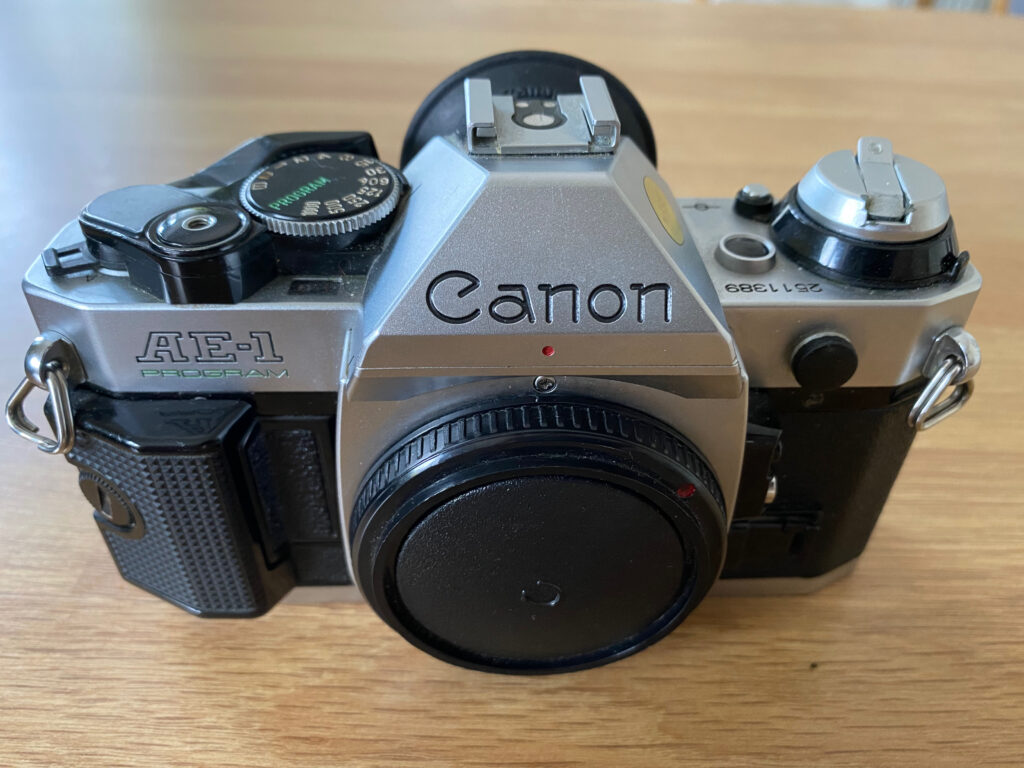
If I had to make just one recommendation for this type of film camera it would be the Canon AE-1 Program. It has everything you could ever want in any film camera, it’s solidly built and will last forever if you treat it with respect. This is a camera you can really learn photography with. It does just enough for you, but most things like focus, compensation and so on are left to you. FD lenses are cheap and plentiful so you can build up a great collection to try out all kinds of photography. I have put countless rolls through mine and it remains my go-to film camera to this day.
I’m not the only one to recommend this, Ken Rockwell was quite pleased with his, too…
Picking up where the original AE-1 (1976) and A-1 (1978) left off, the AE-1 program is a highpoint in all of photography’s history.
Ken Rockwell – https://www.kenrockwell.com/canon/fd/ae-1-program.htm
Auto focus cameras
If you want the absolute best there ever was, then this is the place to start. By the early 1990’s camera manufacturers had all moved on to their latest lens mounts, auto focus systems were standard and as the years went by they resorted to filling cameras with more and more features, refining the old ones and miniaturising designs to make bodies lighter and easier to handle.
Best of all, though, are prices. Right now no one wants these cameras. They don’t have the appeal or charm of the “vintage” models, nor are they manual enough to entice people who want that tactile film feel and the mechanical sound of shutters and winding levers. Don’t write them off, these modern film SLR’s were built as tools and many are extremely well built, reliable, accurate and capable.
Unless you want to buy what were the top of the range cameras in their day, you can pick up most of these bodies for anywhere from £1 to about £30. Having said that, even the best of the best – the Canon EOS 1V comes in at about £450, which is still incredible value for money.
For your first film camera, you really are spoiled for choice and by no means do you need to buy entry level cameras, even on a tight budget.
The excellent website of Flynn Marr has this incredibly useful chart which shows when various Canon film cameras were released, but better still shows who they were aimed at. This gives you a great indication of how robust a body will be, where the price should be and how many features you are likely to get. Obviously, the closer to the top right of the chart you look, the more modern and expensive the camera is and would have been. I recommend reading his site if you want a real background on the whole EOS system.
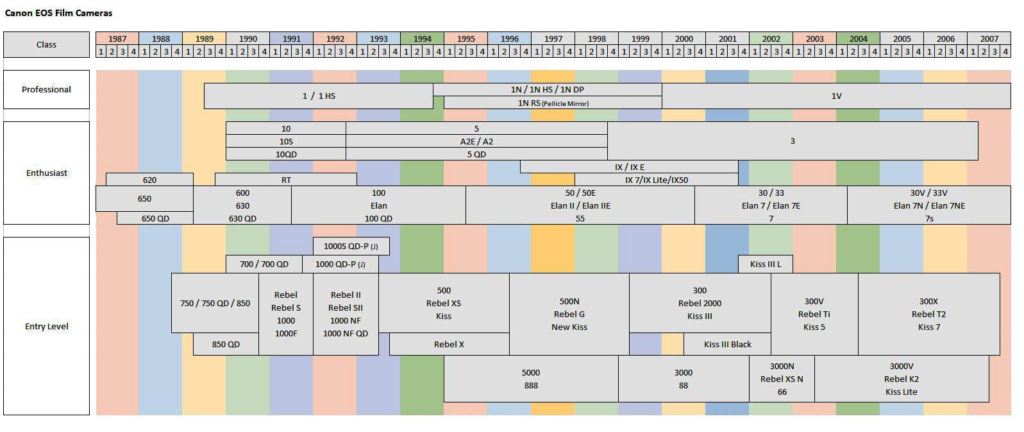
What do I recommend for beginners? The following list will suit all budgets:
- Budget bargain – Canon EOS 1000fn, 300, 300v
- Mid range monster – Canon EOS 50, 30
- I want the best – Canon EOS 1N, 1V
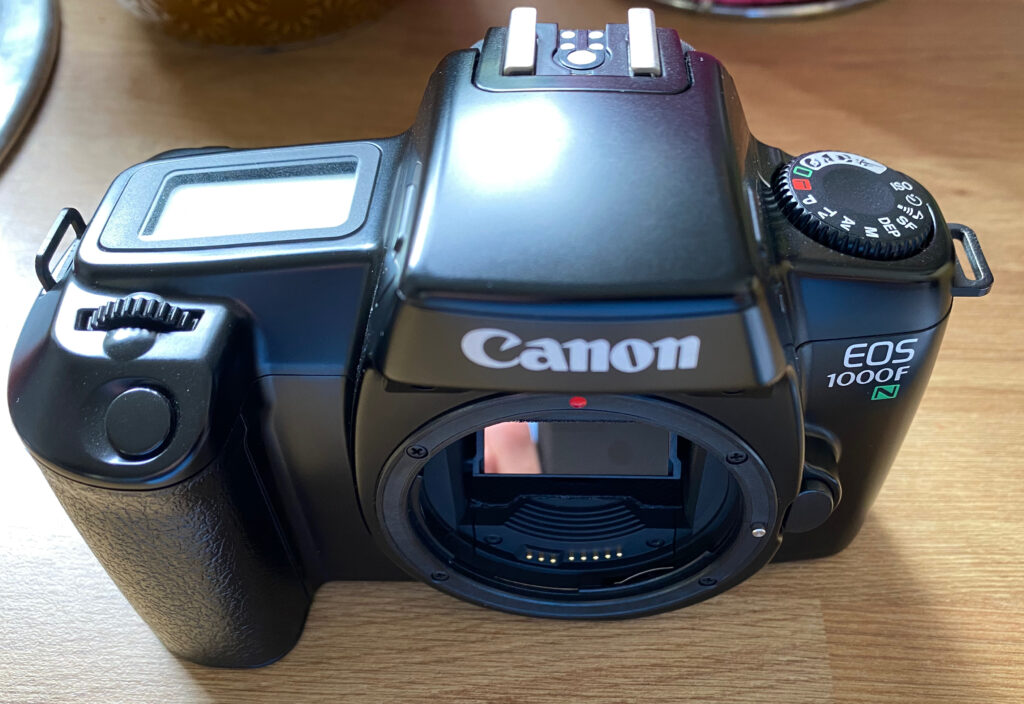
The Canon 1000FN was originally sold as a capable entry level SLR kit for those looking to get into photography for the first time. They were sold for around £300 in places like Dixons and Currys along with a kit lens in various configurations. Because they targeted the mass market and entry level consumers, they sold in their thousands and they are freely available.
The 1000FN has every feature you are likely to need, including AF that works (slowly), compatibility with all EF lenses, auto film load and rewind, manual and automatic shooting modes. It really is a brilliant little camera that feels good in the hand and will carry on shooting long after you’re bored of it. Don’t pay more than £10 for one of these.
The 300 and 300V are the later versions of the 1000FN, they contain faster and better auto focus and have smaller and lighter bodies. There is little to choose between these three models.
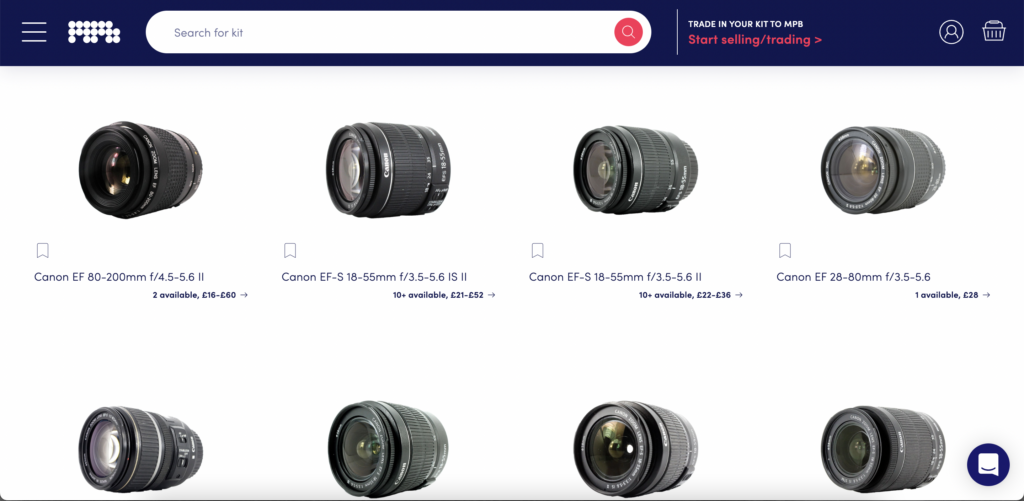
The most significant disadvantage to these types of camera is the price of lenses. Both Canon and Nikon auto focus bodies all use the same lenses as modern digital cameras. Consequently, these lenses are currently desirable, in use and worth a lot of money. There are bargains to be had and a standard 50mm F1.8 can still be picked up for around £50. If you want to browse second hand prices of lenses, you could do worse than browse MPB – they are very sensibly priced and more reliable than ebay.
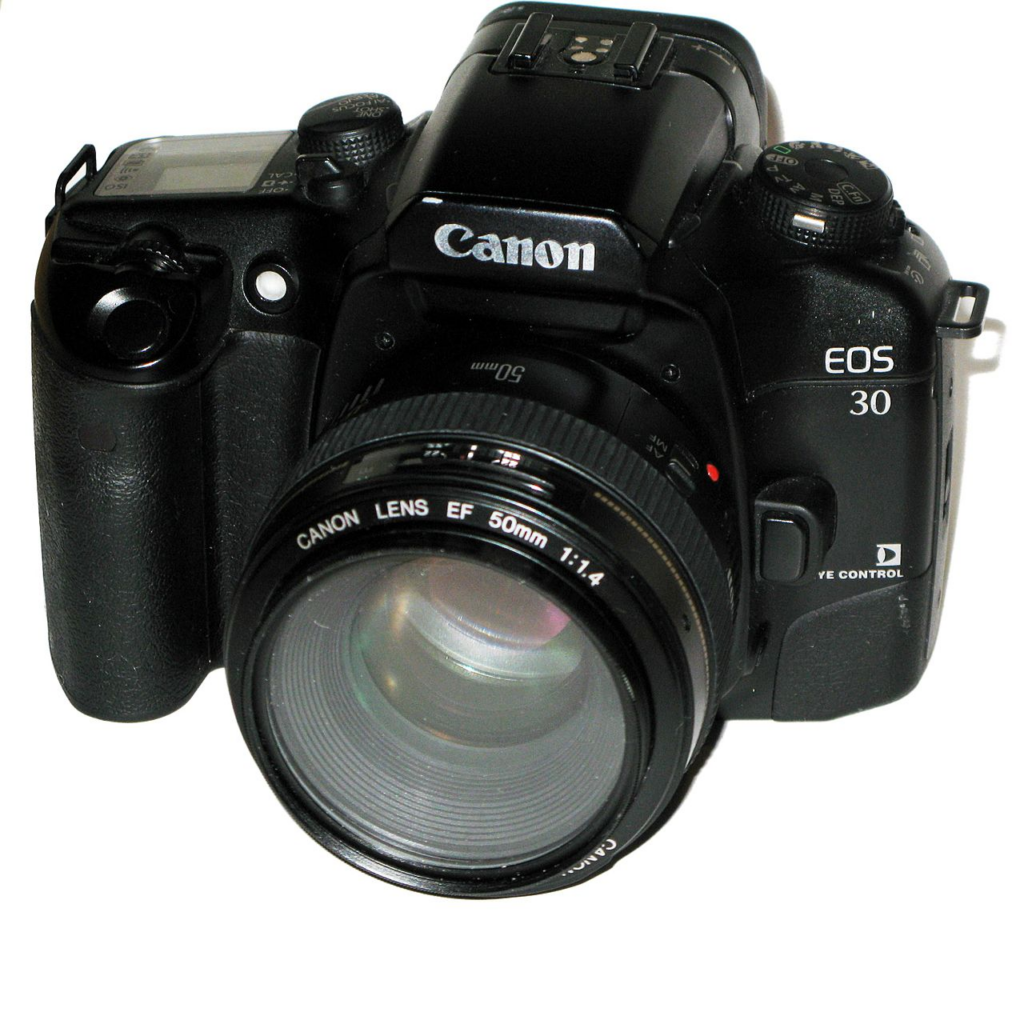
Moving up in both price and quality we have mid range bodies like the EOS 50 and 30. These bodies were aimed at the serious amateur photographer and had every feature you can possibly need. A great deal of thought has gone into the design, meaning they feel superb in the hand and have all the controls where you would expect to find them. These are bodies you can pick up and use without looking at what you’re doing and make changes without moving your eye from the viewfinder.
I personally have owned two EOS 50’s – I regretted selling the first one so much that I bought another to replace it. They are very solidly built, have a good solid shutter sound and some useful custom functions like leaving the film leader out when finished so you don’t need to retrieve it to develop.
The auto focus systems are generally quick and reliable, the metering accurate. They have those features that are missing on cheaper bodies such as different metering, drive and focus modes. These are just dependable cameras full stop. I have previously shot part of a wedding with an EOS 50 and the results were superb. If I were starting out, or could only have one EOS film camera, this would be it.
Expect to pay £20-35 for a reasonable copy and if you get lucky, you can get a boxed one for next to nothing:
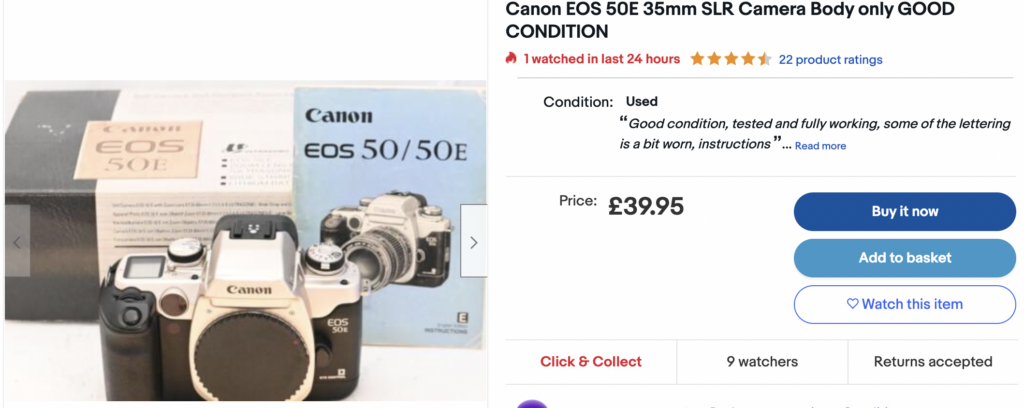
Finally, for those with deep pockets, there is the EOS 1 series. You have to be careful with your searches, because there were three main 1 series cameras and they differ quite significantly.
The plain EOS-1 is a magnificent camera, but because it came along so early on in the development of the range, it actually hasn’t got a great edge in terms of auto focus. What it does have, though, is undeniably rock solid build quality. This is a camera that was meant for professionals and Canon designed it to be able to withstand bouncing around in the back of a car, thrown and knocked in a bag or just generally be abused. These cameras went to war zones, sports events, public unrest, momentous political events and produced some incredibly important images that appeared in newspapers worldwide. Expect to pay approximately £50-90 for the original model.
The refined version is the EOS 1N which came with a host of improvements on its predecessor. Auto focus was vastly improved, as was just about every other feature imaginable. This is almost peak film camera and if you have approximately £150 to spend then you’ll not need to buy another film camera ever, you just won’t have a valid reason. There is nothing the 1N cannot do and it will likely outlive you.
But there has to be a pinnacle, an ultimate and unquestionably this is it:
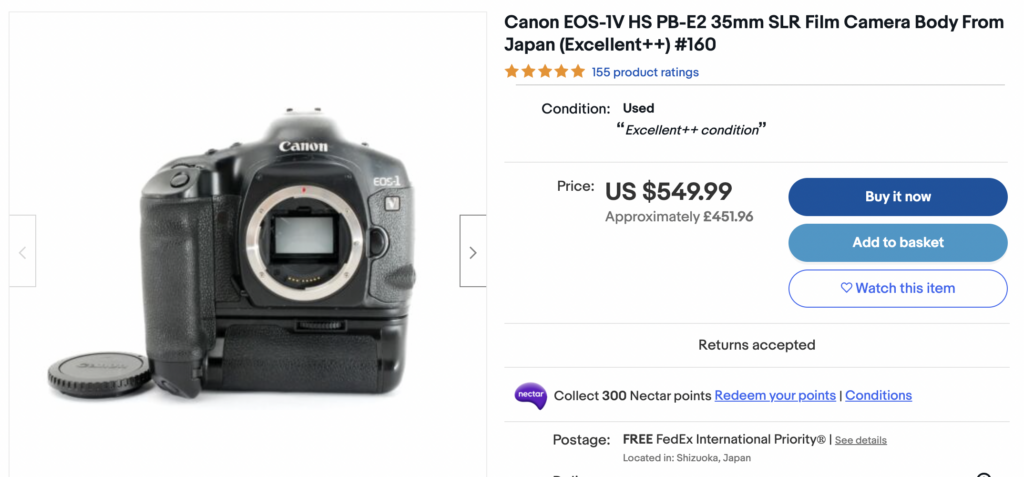
The EOS 1V has everything Canon ever designed, developed and implemented in a film camera body. This machine is capable of blowing through a 36 exposure film in just over 3 seconds. It has an autofocus system which can keep up with anything you throw at it and a robustness that is second to none. This was created to be the ultimate imaging tool and who can deny that, in film terms, it is. I just hope you have a lot of money because you’ll need to buy some very expensive lenses to justify using one of these.
Conclusion
People all over the world are returning to film or discovering it for the very first time. There are thousands who have never known anything other than digital photography in their entire lives, yet are drawn by the process, look and feel of film.
In terms of value for money, nothing comes close to the sheer bang for buck you can get by picking up a second hand SLR and a couple of lenses. As a learning tool, film photography will make you more disciplined, more thoughtful and more considerate about each exposure you make. These are things that are much harder to learn with a digital set up.
Then there’s the developing process. Why would you not want to experience the magic of swishing a film about in chemicals and revealing a strip of images at the end? The possibilities are endless if you then get into enlarging and printing in your own darkroom. Film photography really is a genre which keeps giving and the best of it is you can start for next to nothing – there are virtually no barriers to entry.
So, go on, stop reading and go buy a film camera.
Useful links and resources
- Shooting and developing film guide (this site)
- Massive dev chart
- Developing and scanning film at home video playlist
- Canny Cameras – great website about film shooting on a budget in Scotland/Northern England
- Ilford Film and developer shop
- Discount Films Direct


